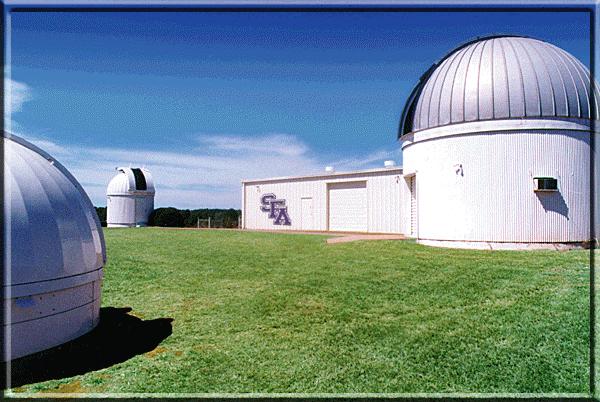Solar Eclipse Viewing
Some members of the SFA Physics faculty will be available for solar eclipse viewing on Monday, Aug. 21, beginning at 11:45 AM. The time of maximum eclipse for SFA is about 1:16pm. These faculty members will gather at the statue of Stephen F Austin in front of the Steen Library and will demonstrate safe viewing procedures and answer questions. Nearby parking is available and families are welcome.
This will be a partial solar eclipse as seen from the SFA campus. Some of the faculty members are traveling to Missouri and Nebraska to see the total solar eclipse. For more information to see www.facebook.com/SFAObservatory
The SFA Observatory will not be open for the solar eclipse at the telescopes there are designed primarily for observing stars and planets.
The SFA Observatory
-
The Department of Physics and Astronomy[1] at Stephen F. Austin State University[2]
operates the second largest Observatory in Texas and the Central Time
Zone. Located eleven miles north of the historic East Texas city of
Nacogdoches, the SFA Observatory proudly carries on and enhances the
tradition of the campus-based facility. The Student Observatory at the
site currently provides 600 introductory astronomy students per year the
opportunity to view and learn the wonders of the sky. The Research
Observatory is used by students and faculty to broaden our understanding
of the universe. It is one of the only facilities of its size in the
world which permits regular use by advanced undergraduate and graduate
students.
The astronomers on staff are the observatory director Dr.
Norman L. Markworth[3] and Dr. Dan Bruton[4].
The Research Observatory
- The two domes of the Research Observatory house
computer controlled 18- and 41-inch telescopes. The 18-inch was
originally used by NASA for lunar studies prior to the Apollo program
and has been in operation at SFA since 1976. It was converted to
computer control in 1979, making it one of the first computer assisted
telescopes at a campus-based observatory. The 41-inch telescope was
designed and constructed by the faculty and staff of the Department of
Physics and Astronomy. Building on the success of the 18-inch control
system, the 41-inch represents a major leap forward in the automation of
telescopes. "First light" was in August of 1984. The thrust of the
research at both telescopes has been photoelectric photometry. The
18-inch is now equipped with a CCD photometer and imaging system, while
the 41-inch boasts a new three channel photometer.
SFA Astronomers have taken leadership roles
in the field of computer controlled telescopes, video processing, and
pattern recognition. An expert system is installed and is being tested
on the 41-inch which will allow the telescope and computer to recognize
and center target stars without operator intervention. To date only
small telescopes have been used in this completely robotic way, owing to
their limited light gathering capabilities. The new expert system is
able to sort through the bewildering array of fainter stars visible to
large telescopes, thereby allowing these telescopes to reap the benefits
of the greater efficiency, precision, and data collection which until
now has been the preserve of their smaller cousins.
A typical night begins in the control room where a
series of programs is executed to instruct the telescope how to find
the objects of interest that night and to efficiently sequence the
observations. As the end of twilight approaches, the operator commands
the telescopes to move to the first object. As the telescope moves to
the target, the dome moves also under computer control. Data on three
closely spaced objects are collected simultaneously which greatly
minimizes the effect of the atmosphere. Having been freed of the tedium
of the observing process, the operator can concentrate on the quality of
the acquired data. Our automated systems have allowed students to
participate in real astronomical research.
The SFA Observatory has a latitude of +31°
45¢ 35.3² = +31.7598°
and a longitude of -94°
39¢
40.5² = -94.6613°.
The address is
651 County Road 124 Nacogdoches, TX
The Student Observatory
- The SFA Observatory is home to the largest
student observatory in the State of Texas. Up to 12 portable 8-inch
Meade LX-90 Schmidt-Cassegrain telescopes[5]
and 4 six-inch Newtonian reflectors can be mounted on rigid pedestals
for student use. A very active chapter of the Society of Physics
Students[6]
regularly hosts public nights at the Observatory. Since many SFA
students come from either the Houston or Dallas-Fort Worth areas, the
views offered through these telescopes in the relatively dark skies of
East Texas is an enjoyable and often unforgettable experience.
Undergraduate and graduate students can participate in Student Research[7].
-
-
Table of Contents
- 41" Telescope
- This telescope was constructed 1984 and is primarily used for variable star research.
- 18" Telescope
- This telescope was moved to SFA in 1976 and is now used to search for minor planets.
- 10" Telescope
- This telescope arrived at SFA in January of 1998 and is a good telescope for training.
- 8" Telescopes
- These twelve telescope arrived at SFA in 2001 and are used in the astronomy courses at SFA.
- Weather Station
- This instrument has been recording data since May of 1999.
- Public Viewing
- You can find out what days the observatory will be open and download driving directions.
- Research Links
- Check out our different areas of research.
|
41-inch Telescope Documentation
18-inch Telescope Documentation
|




